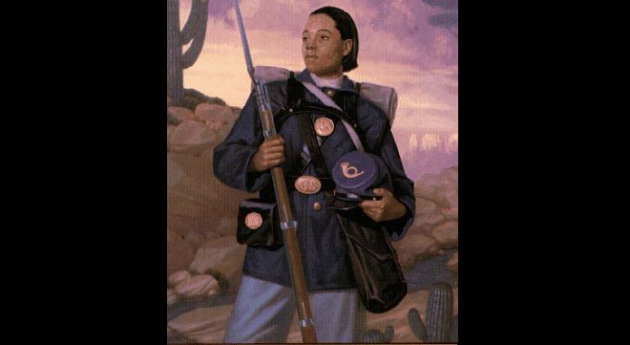

Private Cathay Williams was the only woman to serve in the US Army as a Buffalo Soldier. On November 15, 1866 she enlisted in the Army as a man. Williams reversed her name to William Cathay and lived as a male soldier and served until she was found out due to the last of many illnesses she suffered while a serving. She is the only documented black woman known to have served in the Army during these times when enlisting women was prohibited.
Born in 1844 in Independence, Missouri, Williams was a slave as was her mother but her father was free. She would work as a house servant on the Johnson plantation near Jefferson City. At that time, captured slaves were officially designated by the Union as “contraband,” and many were forced to serve in military support roles such as cooks, laundresses, or nurses. At age seventeen, Williams was impressed into serving the 8th Indiana Volunteer Infantry Regiment.
For the next few years, Williams traveled with the 8th Indiana, accompanying the soldiers on their marches through Arkansas, Louisiana, and Georgia. She was present at the Battle of Pea Ridge and the Red River Campaign. At one time she was transferred to Little Rock, where she would have seen uniformed African-American men serving as soldiers, which may have inspired her own interest in military service.
Despite the prohibition against women serving in the military, on November 15, 1866 Williams disguised her gender and enlisted as William Cathey, serving in Company A of the 38th Infantry, a newly-formed all-black U.S. Army Regiment, one of its earliest recruits. Cathay said she joined the Army because “I wanted to make my own living and not be dependent on relations or friends.”
Cathay initially served at Jefferson Barracks outside St. Louis and was later posted at Fort Cummings and Fort Bayard in New Mexico Territory. Like other black soldiers stationed at remote western outposts after the Civil War, Cathay endured inadequate supplies and inferior weapons. One of the tallest privates in her company, Cathay concealed her femininity for two years despite numerous army hospital visits before her true gender was discovered by the Fort Bayard post surgeon.
Cathay was discharged at Fort Bayard on October 14, 1868 on a surgeon’s certificate of disability. Only two others are known to have been privy to the deception, her cousin and a friend, both of whom were fellow soldiers in her regiment.
Following her discharge from the Army, Cathay resumed her identity as Cathay Williams and lived in Pueblo, Las Animas, and Trinidad, Colorado, where she was known as Kate. In June 1891 Cathay filed a pension application based on medical disability incurred during military service as William Cathay.
There was precedent for granting a pension to female soldiers. Deborah Sampson in 1816, and Mary Hayes McCauley (better known as Molly Pitcher) had been granted pensions for disguising themselves as men to serve in the American Revolutionary War. Sampson’s cause had been championed by none other than Paul Revere. However, Williams had no influential friends to help her.
In September 1891, a doctor employed by the Pension Bureau examined Williams. Despite the fact that she suffered from neuralgia and diabetes, had had all her toes amputated, and could only walk with a crutch, the doctor decided she did not qualify for disability payments. Her application was rejected.
